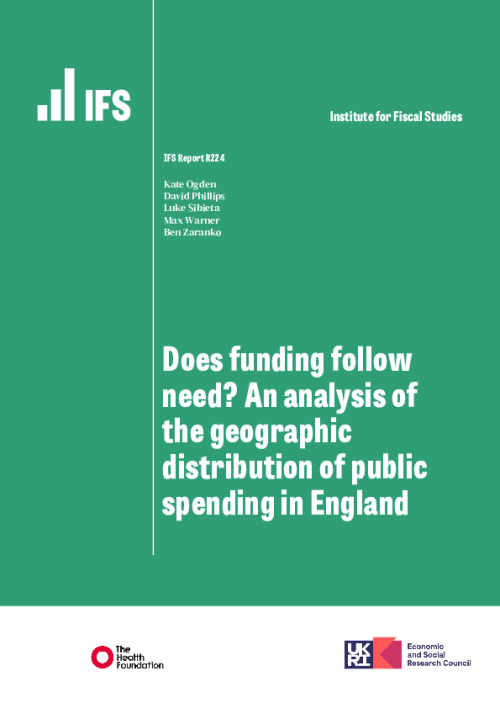Introduction
In 2019–20, the last financial year before the COVID-19 pandemic, government spending that can be specifically attributed to England amounted to £541 billion or £9,650 per person. Of this, around £185 billion (£3,290 per person) was for social security benefits such as the state pension, universal credit and disability benefits. The remaining £356 billion (£6,320) was spent on a range of public services. This includes spending on health (£137 billion), education (£74 billion), transport (£28 billion), public order and safety (£26 billion), adult social care (£19 billion), and housing and community amenities (£10 billion) – services that are vital both directly and indirectly to the health, well-being and life chances of the population. Indeed, recent years have seen increasingly robust evidence emerge that the amount of funding such services receive matters for the outcomes that they deliver for people from more-deprived backgrounds. This is true of health, social care, schools and early-years provision.[1]
Ensuring that funding for public services is allocated across places in an effective and fair manner is therefore vital. But it is of particular importance now given two pressing policy issues.
The first is that a decade of austerity during the 2010s, rising demands and costs associated with an ageing population, and an aim of cutting taxes by the current government mean that funding for public services is – and will continue to be – constrained. When resources are limited, it is particularly important to ensure that they are used effectively.
The second is an ambition to reduce geographical inequalities across England and the UK – the ‘levelling up’ agenda. This is about more than just productivity, earnings and employment – the government’s White Paper sets ambitious targets for both overall improvements and a narrowing in geographical gaps in health, educational attainment, housing quality, crime and local pride. Public services have a key role to play in addressing these dimensions of inequality, but the government has so far said little about one of the biggest direct levers it has in the context of limited overall funding: changes to how funding is allocated between places.
The starting point for changing how funding is allocated is a thorough understanding of the effects of current allocation processes. That is the focus of this report. It reviews both the systems of funding and the resulting funding outcomes for different parts of England for five key service areas: health services; schools; local government services; police services; and housing investment. Each of these contribute to the health and well-being of the population – not only by directly diagnosing and treating illnesses in the case of the NHS, but also by helping to create the wider conditions that allow people to live healthier lives.
This report, funded by the Health Foundation, is part of a wider programme of work on the role of public services in supporting people to live healthier, happier and more productive lives. We hope to build on it with further work on the total funding available for public services in different parts of England, and on the impact of local government funding in particular on service provision and local health and well-being.
The rest of the report proceeds as follows.
Chapter 2 provides an overview of changes in public spending in England in recent decades: how it has changed over time; and how it varies across the nine regions of England. The patterns will reflect the amounts spent on different service areas and how these have changed over time, the characteristics of the different regions of England, and reforms to how funding for different services is allocated to different places.
Chapter 3 then looks at the principles and potential objectives that public service funding systems are designed to meet. This includes not only allocation in accordance with assessed spending needs, but also stability and certainty of funding, the provision of financial incentives for particular behaviours, and enabling a degree of discretion in funding and spending decisions by local policymakers. It explains how there are trade-offs between these objectives and difficulties in implementing them in practice.
Chapters 4–8 then look at the funding systems and allocations for five major areas of public service spending in England in turn: health, schools, local government, housing, and police. What are the objectives? To what extent are they achieved? What are the resulting funding allocations? And how do these compare to assessed spending needs and vary across England?
Chapter 9 concludes and draws out lessons for policy and future research. Overall, we find that while funding systems for some services are coherent and well designed (such as the main NHS funding allocations) or have improved in recent years (such as schools), others need significant reform (such as for police, local government and public health services). During the 2010s, changes to funding allocations often worked to exacerbate rather than reduce geographic inequalities, with higher-needs, more-deprived areas seeing bigger cuts to funding.
The report is accompanied by a full spreadsheet appendix, which includes the data underlying the charts included in the report, as well as additional analyses of funding, assessed spending needs, and local area characteristics.
Upfront, it is also worth defining several terms that we use throughout the report.
- ‘Funding’ is the amount of funding available to the broad service areas we examine (such as health, schools and other local government services), from government grants and, where relevant, locally raised tax revenues (such as from council tax and business rates).
- ‘Spending’ is the amount spent on specific narrower service areas we analyse as part of Chapter 6 on other local government services.
- ‘Assessed spending needs’ are the official assessments of how much needs to be spent on providing a particular set of services in geographical areas to meet the government’s objectives for service provision. This is generally to be able to provide the same range and quality of services in different places, given differences in local service demand and cost factors. But it may also reflect an objective to reduce inequalities in outcomes between places.
- ‘Actual spending needs’ is the underlying, unobservable level of spending that would actually be needed to meet the government’s objectives for service provision. Assessed spending needs may differ from actual spending needs.
[1] See Cattan et al (2021), Crawford, Stoye and Zaranko (2021), Jackson, Johnson and Persico (2016) and Martin et al. (2021).














